|
A Controlled Slice...
Shane Conroy, asst supt, Park Ridge Country Club, Park Ridge, IL:
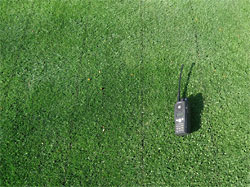
The Verti-Quake on #1 fairway; the disruption to the playing surface is minimal.
|
 "This week we began Verti-Quaking the fairways here at PRCC. This process will take almost two weeks to finish as we will Verti-Quake each fairway in two directions. The Verti-Quake connects to the rear of a tractor and is driven by the tractors PTO shaft. The machine is equipped with multiple blades that rotate into the turf up to 10" deep when the PTO is engaged. The soil under the fairways here at PRCC is mostly a clay loam mix and is prone to heavy compaction throughout the golf season, from both carts and maintenance vehicles alike.
Along with deep-tining, Verti-Quaking is a great way help move water deeper into the soil as well as allow for greater oxygen movement in root zone. This in turn will create a stronger root system and a healthier plant throughout the growing season."
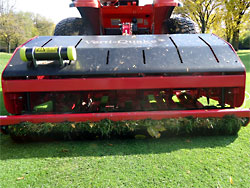
Close up of the Verti-Quake blades.
| 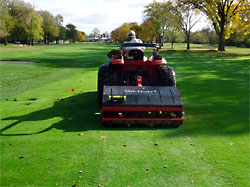
Verti-Quaking 30 acres of fairways (twice) with one machine is a lengthy process.
|
Visit the Park Ridge blog at parkridgeccgrounds.blogspot.com.
|
 |
|
Bunker Face Compaction...
Brandon Collins, Country Club at Woodmore, Mitchellville, MD:
 "With the cooler temperatures lately, the need to water the golf course with the irrigation system has been virtually eliminated for the year. That is mostly good for you, the membership. Fairways and approaches are firmer than they have been all year. This allows for more ball roll and the option to play different shots in to the green. It is also good for us, the Green Department. Drier turf is always better turf. It is less susceptible to disease and traffic damage. Drying out the soil also forces the turf to grow deeper roots as it looks for more water. This helps to set the turf up for next season.
One area it is not good for, however, is our bunkers. One of the biggest challenges that we face on a daily basis is managing the bunkers so that they play consistently from hole to hole. According to the American Society of Golf Course Architects, bunker sand should be replaced every 5-7 years. Most of our bunkers have sand that is well over double this age. Over the years the bunkers have become increasingly difficult to manage; they have different amount silt contamination and most have little to no drainage. It is nearly impossible to make each bunker exactly consistent.
Regular irrigation helps them to keep a somewhat uniform firmness throughout the golf course. When we get in to a dry period like we are now, some of our bunkers tend to get soft on faces and fluffy in the middle. These conditions are not conducive to good lies in the bunker and makes it difficult to hit a good bunker shot. To combat this problem we took a plate tamper around all of the softest bunkers last week.
The process was very effective in bring some uniformity back to the bunkers. We will continue to perform this practice on an as needed basis throughout the playing season."
Visit Brandon's blog at www.ccwoodmoregcm.com.
|
 |
|
Overseeding Clubhouse and Entrance grounds...
Owen Coulson, Vestavia Country Club, Birmingham, AL:
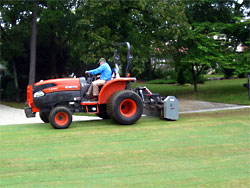
Verticutting to create slits for seed to make contact with soil. Oct. 2
|
 "For the last few years we have overseeded the areas around the clubhouse with ryegrass. The look from this practice is defiantly eye catching. We are able to overseed these areas because they are subject to virtually no traffic throughout the year and not used for golf play.
Here are a few photos of the process through the first mowing."
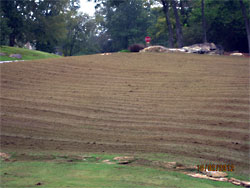
After verticutting a lot of material is left on top of the turf.
| 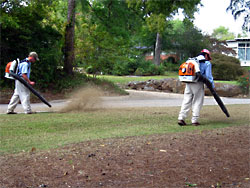
Blowing that material off with backpack blowers.
| 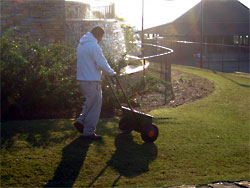
Spreading ryegrass seed after material/mess has been cleaned away.
| 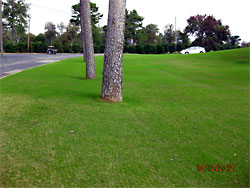
Seed has started to germinate 8 days later.
| 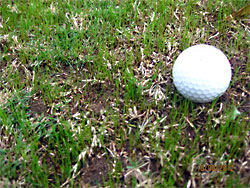
Seed germinating.
| 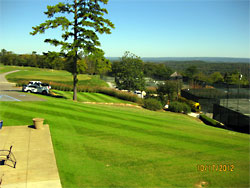
After first mowing.
|

After first mowing only 13 days after seeding.
|
Visit Owen's blog at vccturfgrass.blogspot.com.
|
 |
|
Salamanders and Snails...
Matt Crowther, CGCS, Mink Meadows Golf Club, Martha's Vineyard, MA:
 "When mowing greens one morning I ran into some interesting wildlife on a couple of different greens. Seems I remember seeing salamanders in the 4-5 area in the past. As the sight of these guys flooded me with memories it occurred to me that it is always at this time of year. No idea why as I have never done any research into salamanders so whether they are migrating or heading to over-wintering spots or just on the move I cannot tell you. They were clearly different from each other in color, whatever that means.
The snail had traveled a long way. It was a heavy dew that day and so the tracks being left were a dead giveaway.
When mowing you are always on the lookout for anything that could damage the mower or the green. It's not uncommon to see earth worms or ground beetles and an occasional ground spider web in the dew, but anything else gets your attention."
Visit Matt's blog at minkmeadows.blogspot.com.
|
 |
|
Tee Encroachment...
Steve Cook, CGCS MG, Oakland Hills Country Club, Bloomfield Hills, MI:
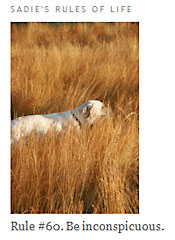  "Each fall we recapture lost teeing ground. During the course of a season or two the tee edges move slowly inward from routine mowing. A cautious mower operator will error on the side of not scalping the edges, always cutting just a little bit on the inside edge of the tee perimeter. Over time, the tees become smaller.
So we cut back to the original edge in cooler weather when scalped turf recovers easily. Some tees are more pronounced than others, but that is why you are seeing scalped edges on tees... it's intentional."
Donald Ross on Trees:
"As beautiful as trees are, and as fond as you and I are of them, we still must not lose sight of the fact that there is a limited place for them in golf. We must not allow our sentiments to crowd out the real intent of a golf course, that of providing fair playing conditions. If it in any way interferes with a properly played stroke, I think the tree is an unfair hazard and should not be allowed to stand."
- Donald Ross, from Golf Has Never Failed Me
Visit Steve's blog at ohccturf.blogspot.com/
|
 |
|
Fall Cleanup...
Dan Salois, Highland Meadows Golf Club, :

"After a windy weekend, it is easy to understand that the course would be quite messy come Monday. Few people probably appreciate the amount of time and labor we spend just keeping the course playable this time of year.
Here's just a brief snapshot of a typical fall day 'behind the scenes' as three crew members battle a pile of leaves on #8. The fall color is beautiful, but we've got a month of this yet to go. Ugh."

Visit Dan's blog at hmgcmaintenance.blogspot.com.
|
 |
|
Bluebird Boxes from 'Native' Lumber...
Heath Puckett, CGCS, Cypress Lakes Golf & Country Club, Muscle Shoals, AL:
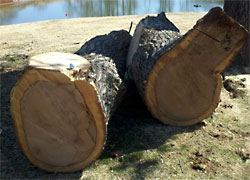
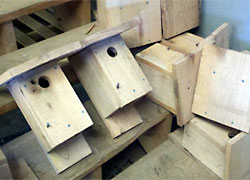
|
 "These two logs came from the large red oak tree by the pumphouse that fell during a storm. They were milled onsite by a local sawyer into 1″ lumber, which we stored at the maintenance facility to air-dry. Last winter, on very cold mornings, we built over 30 bluebird houses out of this lumber.
Golf courses provide community green spaces that offer not just recreational opportunities for people, but key sanctuaries and habitat for wildlife.
Bluebirds are territorial and will usually not allow another pair to nest in the approximately 2 acres they claim as their own. A good understanding of the breeding cycle of bluebirds is essential to developing a management program that will help to ensure that the bluebirds using these houses will be successful in raising their families. We monitor activity on a consistent basis, clean out the houses after each season, and established a record-keeping system to gauge the success of our project."
Visit Heath's blog at cypressturf.wordpress.com/.
|
 |
 |
|
About our Blog Aggregator: Many superintendents are now hosting private blogs to better communicate with their golfers and/or members. Beyond local weather and course conditions, there is a great deal of information about projects, methodologies and techniques that would be of value to other superintendents — hence our Turf Blog Aggregator. As every blogger struggles occasionally with content, we also include posts intended to educate golfers about turf maintenance for others to use as a template for their own blogs.
Miss any previous issues of TBA? You can find them all here.
Turf Blog Aggregator(TM) is a trademark of Turnstile Media Group.
|
|